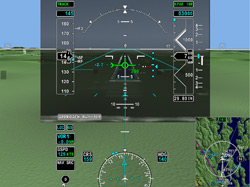 Prototype Honeywell PFD merges infrared imagery with synthetic vision. The pilot can adjust the brightness of the infrared insert.
Prototype Honeywell PFD merges infrared imagery with synthetic vision. The pilot can adjust the brightness of the infrared insert.
Honeywell is working on new visual displays intended to allow lower landing minimums. The displays have been in testing at Honeywell’s Deer Valley, Ariz., facility, and incorporate synthetic vision plus infrared sensor input.
By merging the two image inputs on the company’s Primus EPIC “SmartView” primary flight display, the combined imagery is meant to enable equivalent visual operations (EVO). The infrared imagery can be toggled by the pilot, allowing him or her to dial in the best mix of synthetic terrain and infrared imagery.
This capability could well lead to the technology’s blessing for use in conventional Category I, II, and III instrument landing system (ILS) approaches. The FAA NextGen “roadmap” for future navigation plans on the introduction of EVO in the 2012 to 2016 time frame, Honeywell notes.
The new technology eliminates the need for a head-up display (HUD), Honeywell says, and can increase access to more destinations and avoid weather-related delays.
Yet another Honeywell initiative would put Honeywell-developed airport diagrams on Primus EPIC multifunction displays. The idea is to provide the highest resolution available, along with ATC-issued taxi routes plotted on the screen and highlighting of airport “hot spots” where runway incursions have been a problem. Finally, the ADS-B-generated positions of other taxiing aircraft can be plotted on the display, giving pilots total situational awareness during ground operations.
To date Honeywell has flown more than 25 hours on aircraft modified to house an infrared sensor; research on the concept began in 2005. Currently, some 450 to 500 business jets are equipped with Honeywell’s Primus EPIC avionics suites and are capable of these upgrades.



